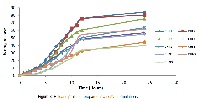Preparation and Evaluation of Curcumin Invasomes
Keywords:
Curcumin, Cyclodextrin, Invasomes, HPMCK4M gelAbstract
Curcumin has poor aqueous solubility and has bioavailability problems. Hence in the present study the solubility of curcumin was increased by complexing with cyclodextrin (CD) and Hydroxy propyl β cyclodextrin(HPβCD). This complex is incorporated in to invasomes and then into HPMC gel to prepare as a transdermal formulation.Curcumin cyclodextrin complexes were prepared by physical mixture and co-precipitation method. Different formulations of invasomes containing 0.5, 1.0, 1.5 % of limonene, fenchone, nerolidol individually were prepared using mechanical dispersion technique. Invasomes were characterized for vesicular size, surface morphology, zeta potential, entrapment efficiency and percutaneous permeation.Formulations CHL1 and CHL2 were optimized for further studies. It was found in the study that complex with HPβCD in 1:2 proportion prepared by coprecipitation method was found to bind 90% of curcumin.Invasomal preparation with 0.5% limonene, 4% ethanol was found to enhance permeation by 8.11 times the control.In vivo diffusion studies were conducted using franz diffusion cell, ex vivo skin permeation studies of CHL1using rat abdominal skin showed cumulative drug permeated (Q24)of 70.32 øg/cm2, steady state transdermal flux of 3.344 øg/cm2/hr-1, permeability coefficient of 5.35 cm/hr and lag time of 1 hr when compared with control formulation. From the results it was concluded that the solubility of curcumin increased by complexing with HPβCD and invasomal preparation with 0.5% limonene has improved permeation through the skin.
References
Moin K. Modasiya, Vishnu. M. Patel. Curcumin: Properties and medicinal applications. American Journal of PharmTech Research. 2011; 1(3): 39 – 56.
G. Astray, C. Gonzalez-Barreiro, J.C. Mejuto, R. Rial-Otero, J. Simal-Gandara. A review on the use of cyclodextrins in foods. Food Hydrocolloids. 2009; 23(7): 1631 – 1640.
Pan, M. H., Huang, T.M., Lin, J.K., Biotransfromatin of curcumin through reduction and glucuronidation in mice. Drug Metabolism and Disposition. 1999; 27: 486 – 494.
Kuo-Yi Yang, Lei-Chewen Lin, Ting-Yu Tseng, Shau-Chun Wang, Tung-Hu Tsai. Oral bioavailability of curcumin in rat and the herbal analysis from Curcuma longa by LC-MS/MS. Journal of Chromatography B. Analytical Technologies in the Biomedical and Life Sciences. 2007; 853(1-2) june: 183 -189.
Zaibunnisa A. H., Siti Rashmima R. Nur Ain A. H. Stabilisation of curcumin with γ-cyclodextrin: phase solubility study and its characterization. International Proceedings of Chemical, Biological and Environmental Engineering. 2011; 7: 9 – 13.
Preetha Anand, Ajaikumar B, Kunnumakkara, Robert A. Newman, Bharat B. Aggarwal. Bioavailability of Curcumin: Problems and Promises. Molecular Pharmaceutics; 4(6): 807 – 818.
Mohamed Badran, Gamal Shazly, Mohmoud El-Badry. Effect of terpene liposomes on the transderamal delivery of hydrophobic model drug, nimesulide: Characterization, stability and in vitro skin permeation. African Journal of Pharmacy and Pharmacology. 2012; 6(43): 3018 – 3026.
Nina Dragicevic-Curic, Dietrich Scheglmann, Volker Albrecht, Alfred Fahr. Development of different temoporfin-loaded invasomes-novel nanocarriers of temoporfin: Characterizatrion, stability and in vitro skin penetration studies. Colloids and Surfaces B: Biointerfaces. 2009; 70: 198 – 206.
Thirapit Subongkot, Sureewan Duangjit, Theerasak Rojanarata, Praneet Opanasopit, and Tanasait Ngawhirunpat. Ultradeformable liposomes with terpenes for delivery of hydrophilic compound. Journal of Liposome Research. 2012; 22(3): 254 – 262.
Hajime Matsuda, Hidetoshi Arima. Cyclodextrins in transdermal and rectal delivery. Advanced Drug Delivery Reviews. 1999; 36: 81 – 89.
Murali Mohan Yallapu, Meena Jaggi, Subhash C. Chauhan. Β-Cyclodextrin-curcumin self assembly enhances curcumin delivery in prostate cancer cells. Colloids and surfaces B: Biointerfaces. 2010; 79: 113 – 125.
Anant Paradkar, Anushuman A. Ambike, Bhimrao K. Jadhav, K.R. Mahadik. Characterization of curcumin – PVP solid dispersion obtained by spray drying. International Journal of Pharmaceutics. 2004; 271: 281 – 286.
Nina Dragicevic-Curic, Dietrich Scheglmann, Volker Albrecht, Alfred Fahr. Temoporfin-loaded invasomes: Development, characterization and in vitro skin permeation studies. Journal of Controlled Release. 2008; 127: 59 – 69.
D. D. Verma, A. Fahr. Synergistic penetration enhancement effect of ethanol and phospholipids on the topical deliver of cyclosporine A. Journal of Controlled Release. 2004; 97: 55 – 66.
Boddupalli Bindu Madhavi, Kallem Siri Vennela, Prasad Masana, Bhavana Madipoju. Enhanced transdermal drug penetration of curcumin via ethosomes. Malaysian Journal of Pharmaceutical Sciences. 2013; 11(1): 49 – 58.
Ayman F. El-Kattan, Charles S. Asbill, Nanhye Kim, Bozena B. Michniak. The effects of terpene enhancers on the percutaneous permeation of drugs with different lipophilicities. International Journal of Pharmaceutics. 2001; 215: 229 – 240.
Kalpana B, Lakshmi P K. Transdermal permeation enhancement of Tolterodine tartrate through invasome and iontophoresis. Der Pharmacia Lettre, 2013; 5(6): 119 – 126.





